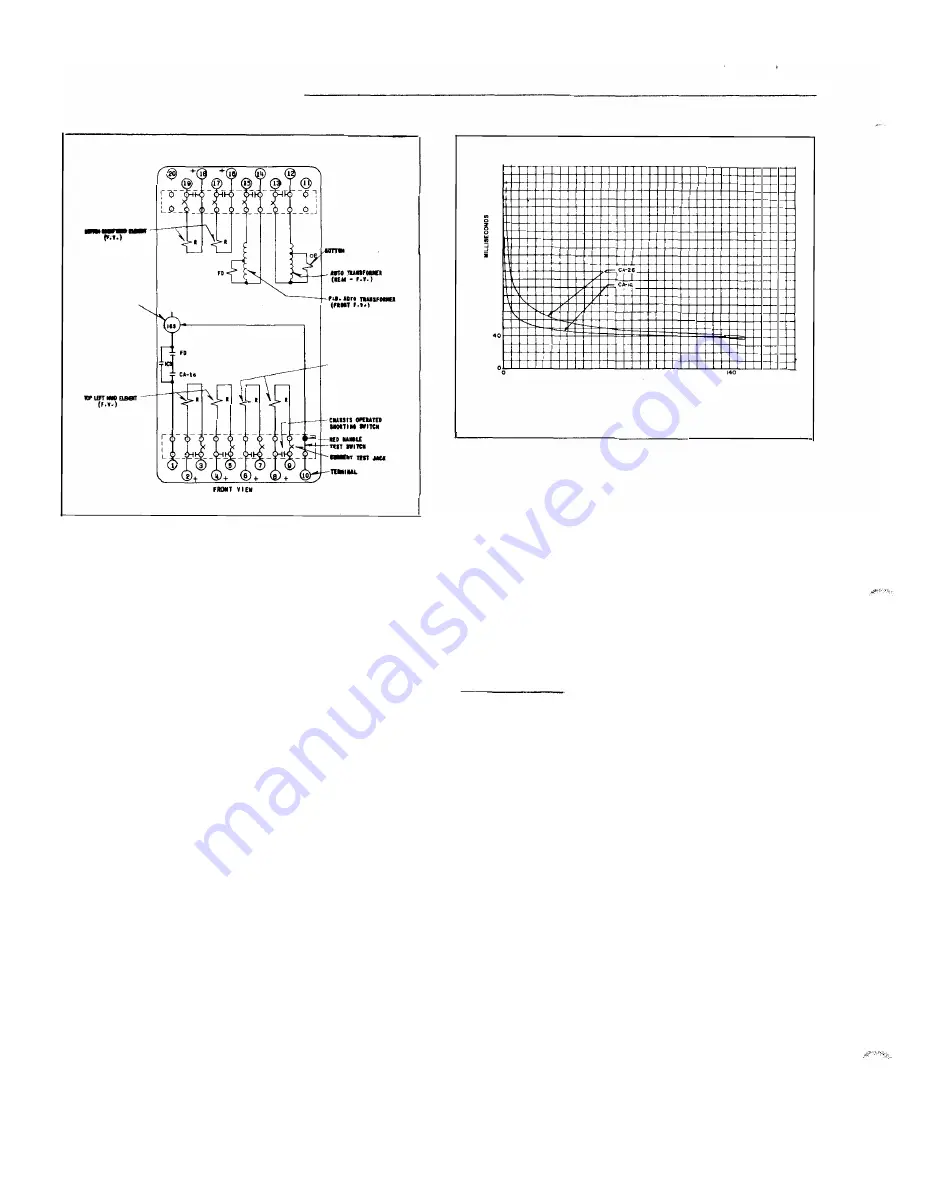
T Y P E S CA- 1 6 AND CA-26 R E L AYS
····"··
CIITACt• •nu
lOTI!:
WIT" IEI.AT I'fE IISTAI•
TAJEOUS POUIITIU
.U
ltiM·
TIE AMI>EIE
lUllS I I TNE PAllED
IUTIA IIUI tOILS ADD
TO
NOOI.It£ MAXIMUM
naquE.
un ... a�
( ...
.
,
'D'IlH- BMII'
(f.'�}
187A434
Fig.
5.
Internal Schematic of the Type CA- 1 6 B us Relay
with a Sensitive Fault Detector
switch. When the switch clos e s , the moving c ontacts
bridge two stationary c ontacts , completing the trip
circuit . Also during this operation, two fingers o n
the armature deflect a spring located on the front of
the switch which allows the operation indic ator target
to drop. The target is reset from the outside of the
case by a push rod located at the bottom of the c over.
A core screw accessible from the top of the switch
provides the adjustable p ick-up range.
O P E R A T I O N
The types C A- 16 and CA-26 rel ays are induction
disc relays with four electromagnets mounted on two
discs that are fastened on a common shaft. One of
the elect romagnets is the op erating element while
the other three are restraint elements. The re straint
elements are energized from the secondaries of c ur
rent transformers connected to the b us , and the
operating circuit is energized in accordance with the
current flowing in the differential c onnection of the
current transformers .
A current of
5
an1peres in at terminal 1 8 and out of
terminal 1� will produce a definite amount of re
straining torque (see Fig.
3 . )
Similarly, a c urrent of
5
amp ere s flowing in at terminal 1 6 and out of ter
minal 17 will produce an e qual amount of torque . If
both of these currents flow at the same time with the
4
240
200
160
�
120
w
2
�
ll
00
�
20
40
60
80
100
120
160
OPERATING CURRENT IN
AMPERES
Curve
5379 56
Fig. 6. Typ ical Time Curves of the CA- 1 6 and CA-26 dif
ferential Relays
polarity as indicated above , their effect will be addi
tive and they will produce the same torque as though
10 amperes were flowing in terminal 16 and out of ter
minal 1 7. Conversely , if e qu al currents flow in these
two coil s , but in opposite directions, their ampere
turns will cancel and no torque will be produced. The
same rel ationship applies for the p aired coils of the
other two restraining units of the relay.
C H A R A C T E R ! S T E R I C S
CA- 1 6 B u s
Relay
This relay has v ariable percentage characteristics
which means that the operating coil current required
to close the relay contacts, expressed in p er cent of
the total restraint current , v arie s with the m agnitude
of the restraint current. The rel ay sensitivity is high,
corresponding to a low percentage ratio , at light c ur
rents, and its sensitivity is low, c orresponding to
high percentage unbal ance , at high currents. The re
lay is made sensitive at l ow currents in order to de
teet light internal faults on the bus being p rotecte d .
At the same time, however, its reduced sensitivity at
the higher c urrents allows the various c urre nt trans
formers involved to depart from their true ratio t o a
l arge extent w ithout causing false tripping of the re
lay for external faults.
The v ariable percent age characteristics are par
tic ularly advantageous when severe saturation of cur
rent transformers is caused by the d-e c omponent of
asymmetrical short circuits. In the case of buses
located close to generating stations where the d-e
components decay slowly, the breakdown
in
ratio of
the current transformers will be much greater than
www
. ElectricalPartManuals
. com
















































